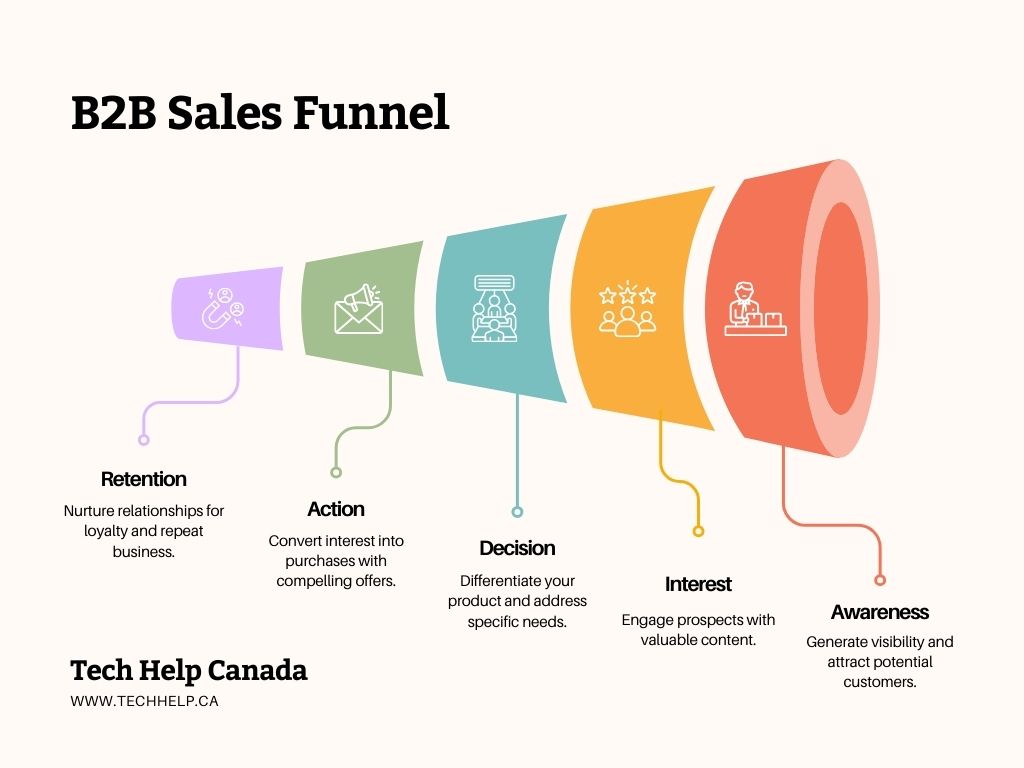In the competitive B2B market, mastering sales funnels is crucial for survival and success. This article explores how to create and improve a B2B sales funnel that attracts leads and turns them into loyal customers. It provides the necessary tools and knowledge to track your prospects’ journey from their first interest to the final purchase. It ensures that every part of your sales funnel helps towards significant growth and better sales outcomes.
What is a B2B Funnel?
A B2B (business-to-business) sales funnel is a structured process that guides potential B2B clients through various stages, from initial awareness about a product or service to the final purchase decision. This funnel is a systematic approach to converting prospects into customers by directing them through predefined steps.
Benefits of B2B Sales Funnel
A well-thought B2B sales funnel can bring several strategic advantages to your business-to-business operations, refining the overall sales and marketing efforts.
Here are some of the key benefits.
1. Efficient Resource Allocation
The funnel structures the sales process so that resources are smartly allocated, focusing efforts on the most engaged leads. This efficiency not only saves time but also optimizes the use of marketing budgets and personnel resources.
Example
A software company uses a sales funnel to prioritize leads who have shown the most interest by attending webinars and downloading whitepapers. This ensures that their sales team spends more time on high-potential leads, increasing the likelihood of conversion while minimizing wasted effort on less engaged prospects.
2. Predictable Sales Cycle
The funnel predicts the buyer’s journey by defining clear stages in the sales process. This predictability allows companies to fine-tune their sales strategies at each stage, anticipate customer needs, and prepare more effective responses to common obstacles in the sales cycle.
Example
An enterprise solutions provider can forecast its quarterly revenue more accurately because their sales funnel clearly outlines the stages from initial contact to final purchase. This allows the company to confidently plan for resource allocation, staffing, and inventory management.
3. Scalability of Sales Efforts
As businesses grow, maintaining control and effectiveness in sales becomes more challenging. A well-defined B2B sales funnel supports scalability, allowing companies to manage an increasing number of leads without losing the quality of engagement and interaction.
Example
A marketing agency expanding its client base uses a CRM integrated with its B2B sales funnel. This system allows them to automate follow-ups, track interactions, and manage a larger volume of leads while maintaining personalized communication, ensuring they can scale efficiently without compromising service quality.
4. Refined Customer Targeting
With deeper insights from monitoring the funnel, businesses can more accurately target potential customers. This targeting goes beyond demographics and firmographics to include behavioral data and engagement levels, ensuring that marketing efforts are directed toward prospects most likely to convert.
Example
A B2B SaaS company refines its ad campaigns by analyzing funnel data. This data shows that prospects who engage with demo videos are more likely to convert. The company then targets ads specifically to those who have watched similar content, leading to a higher conversion rate.
5. Feedback Loop for Continuous Improvement
The sales funnel provides a framework for continual analysis and feedback. By examining the effectiveness of different funnel stages, companies can repeat their sales and marketing strategies, leading to continuous improvement in tactics and customer engagement.
Example
A cybersecurity firm reviews its B2B sales funnel quarterly to identify stages where prospects drop off. They find that many leads are lost after initial contact, prompting the firm to enhance their follow-up strategy with more personalized emails and additional educational content, which leads to a higher retention rate.
Steps to Build a B2B Sales Funnel
Here’s a step-by-step guide on how to build a B2B sales funnel that nurtures leads effectively.
1. Awareness
In this stage of the funnel, the focus is generating visibility among potential customers. This stage is critical for setting the groundwork for future engagement.
Listed below are some effective strategies for spreading awareness.
- Targeted Advertising: Employing digital ads tailored to specific demographics or industries. Using platforms like LinkedIn, which cater to professional networking, companies can deliver precise messages to the right audience, increasing the likelihood of attracting interested parties.
- Content Marketing: Creating and distributing valuable, relevant, consistent content to attract and retain a clearly defined audience. This could be through informative blog posts, whitepapers, and ebooks that address common industry challenges or highlight case studies. Well-crafted content attracts leads and positions your brand as a thought leader in your field.
- Social Media Campaigns: Utilizing platforms where your target audience is active to share content, engage in conversations, and promote your brand. For example, many businesses are active on LinkedIn. Regular posting and interaction help maintain top-of-mind awareness. Integrating social media effectively ensures a broader reach and can drive traffic to your primary web assets.
2. Interest
In the second stage of the sales funnel, the aim is to grow initial awareness into serious interest. It’s important to use educational content that provides real value. You effectively address their questions by offering resources like eBooks, which cover topics relevant to your audience’s needs and goals, as Aha Apps did here.
Other effective resource types to consider are as follows.
- Webinars: These are great for live interaction, offering demonstrations and expert advice, strengthening the bond between your brand and potential customers.
- Newsletters: Sending newsletters that provide regular updates, industry news, and content tailored to their interests helps keep prospects informed and engaged.
- YouTube Videos: Creating YouTube videos that educate and inform your audience on relevant topics can significantly boost their interest. Video content is highly engaging and easily shareable, making it an excellent tool for building interest.
3. Decision
In the decision stage of the B2B sales funnel, potential clients are actively comparing your offerings against competitors. It’s crucial to differentiate your product or service by emphasizing unique selling points (USPs).
Here are some things you can do.
- Personalized Communications: Customize your messaging to address each prospect’s specific pain points or goals. Show them how your solutions better align with their needs than others in the market.
- Testimonials and Case Studies: Leverage the power of social proof by sharing stories and outcomes from current customers. Demonstrating real-world success stories can greatly influence decision-makers by showcasing your offerings’ practical benefits and reliability.
- Detailed Demonstrations: Offer in-depth demonstrations or free trials to give prospects a hands-on experience of your product’s work. This not only builds trust but also allows them to see the efficacy of your solution firsthand.
4. Action
At the action stage of the sales funnel, your goal is to convert interest into definitive purchases. This phase should guide potential customers toward final decisions through compelling calls to action. To effectively facilitate this transition, you can take the following steps.
- Incentivize the Decision: Employ strategic incentives like limited-time offers, exclusive discounts, or attractive bundle deals. These can create a sense of urgency and enhance the perceived value of your offering.
- Simplify the Purchasing Process: Ensure the process from decision to purchase is as straightforward as possible. Remove any barriers that might deter a prospect, such as complicated forms or ambiguous pricing structures.
- Reassure with Guarantees: Introduce satisfaction guarantees or flexible return policies to reduce perceived risks and boost buyer confidence.
- Provide Exceptional Support: During this critical decision-making phase, offer exceptional support through live chats, quick response helpdesks, and detailed FAQs to address last-minute queries or concerns.
5. Retention
Without this stage, your B2B sales funnel would be incomplete because retention is critical for sustainable business growth in B2B markets. After a customer makes a purchase, nurturing the relationship further is essential to provide loyalty and encourage ongoing transactions. Effective retention strategies include the following.
- Follow-Up Emails: Send personalized emails thanking customers for their purchase, offering helpful resources related to their purchase, and checking in on their experience. This keeps communication lines open and can prompt feedback or resolve issues promptly.
- Customer Support Services: Provide comprehensive, accessible customer support. This can be through dedicated support lines, live chat systems, or help desks that ensure customers feel supported in their post-purchase experience.
- Loyalty Programs: Develop loyalty programs that offer exclusive benefits, discounts, or access to premium content or services. This can enhance customer engagement and increase the likelihood of repeat purchases.
- Engagement Campaigns: Run regular engagement campaigns that keep your brand top-of-mind. This might include newsletters, updates on new features, and customer-exclusive events.
- Requesting Feedback: Regularly solicit feedback through surveys or direct outreach to understand your products’ performance and where your service could improve.
Mistakes to Avoid in the B2B Sales Funnel
Several common mistakes can undermine the effectiveness of your sales strategies when managing B2B sales funnels. Avoiding these pitfalls can significantly enhance your ability to convert leads into loyal customers.
1. Prioritizing Sales Over Relationships
Focusing solely on closing sales without building relationships can lead to short-term gains but long-term losses. Therefore, establishing trust and rapport with prospects is crucial.
2. Over-reliance on Automation
While automation is helpful, overusing it can make interactions feel impersonal. Use technology to enhance personal connections, not replace them.
For example, if a customer requests urgent help in chat, sending repetitive automated messages will only increase their frustration and helplessness, leaving a bad impression of your company.
To address this, you can train your chatbot to recognize keywords like “urgent,” ensuring these cases are prioritized for human intervention. This strategy will enhance customer satisfaction and protect your company’s reputation by providing timely and personalized assistance.
3. Poor Lead Nurturing
Poorly nurturing leads can result in lost opportunities. Implement effective targeted content and follow-up communications to keep prospects engaged.
For example, a software company can lose leads due to generic follow-ups. However, suppose they start addressing specific pain points of tech startups, manufacturing firms, and financial institutions. In this case, they can keep prospects engaged, resulting in higher conversion rates and fewer lost opportunities.
4. Neglecting Current Clients
Overlooking the needs of existing customers while chasing new prospects can damage long-term business prospects. Therefore, you ought to balance acquisition and retention efforts.
5. Inadequate Lead Segmentation
Appropriately segmented leads can lead to efficient marketing efforts. Tailor your messaging and offer to fit different segments to increase conversion rates.
For example, a B2B consulting firm can improve conversion rates by segmenting leads based on company size and industry. They can tailor messaging for Small Tech Startups with flexible packages, Mid-Sized Manufacturing Companies with efficiency solutions, and Large Financial Institutions with compliance expertise. This targeted approach can boost engagement and conversions, addressing specific needs for each segment.
6. Ignoring Customer Feedback
Not utilizing customer feedback can prevent improvement in your sales process. Always seek and integrate customer feedback to refine your funnel stages.
Conclusion
Mastering the B2B sales funnel is key to unlocking success in business-to-business sales. By meticulously mapping out each funnel stage, from lead generation to closing deals, you can ensure more efficient, targeted, and effective interactions with potential clients. Implementing well-defined strategies, avoiding common pitfalls, and continuously refining your approach will help transform prospects into loyal partners. Embrace these practices to thrive in the dynamic world of B2B sales, turning opportunities into sustained business growth.

We empower people to succeed through information and essential services. Do you need help with something? Contact Us.
Want a heads-up once a week whenever a new article drops?








